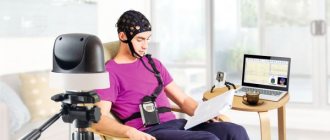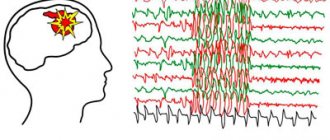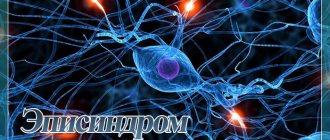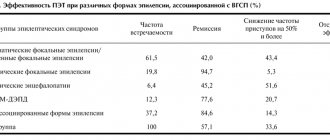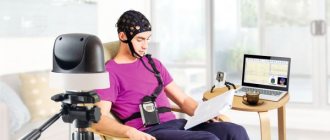Experts differ on the causes of this disease. Neurologists are dominated by two points of view regarding the circumstances that precede the onset of pathology.
- Hereditary factor (benign epilepsy of infancy occurs precisely due to the genetic predisposition of the child’s body).
- Impaired development of the cerebral cortex (lag in the development of nerve cells) - recent research inclines neurologists to this position, which is indirectly confirmed by the cessation of the disease upon reaching adolescence.
What scientists agree on is the reason for the recovery of children upon reaching puberty: foci of epilepsy disappear when the excitability of nervous tissues decreases, which happens as they mature.
How does the disease progress?
The peaks of Rolandic epilepsy pass without loss of consciousness and take the form of attacks with tingling, numbness and tingling of half the face (the affected sides may change with each new case. Sometimes benign epilepsy in children ends with convulsions at night. Experts associate this with the sleep process.
At the onset of a seizure, observant parents often notice changes in the child’s behavior - children complain of pain in the tongue and gums, as well as “goosebumps crawling across the face.” After the onset of an attack, the following symptoms of benign epilepsy are noted:
- spasms affecting the face and throat (usually half the muscles contract);
- spasms affecting the lips and tongue;
- increased salivation;
- speech impairment (due to numbness of the tissues of the oral cavity - primarily the tongue);
- strange throat sounds, reminiscent of wheezing when breathing.
Often attacks are sporadic and occur mainly at night, so some parents are not aware of their child’s illness.
Causes of benign rolandic epilepsy
The exact causes of the disease are unknown. However, there is a hypothesis that confirms the hereditary nature of the pathology. The disease may occur due to a pathological disorder in the maturation of the cerebral cortex in the central temporal region.
As for benign epilepsy, its dependence on the patient’s age has been proven, since it is often diagnosed in children. The pathology may be caused by increased excitability of the children's brain. This can happen for a variety of reasons:
- predominance of excitatory neurotransmitters;
- structural and functional features of epileptogenic areas (hippocampus, neocortex, amygdala);
- low GABA content;
- increased number of excitatory reentrant synapses;
- immaturity of GABA receptors.
As the child's brain matures, its excitability decreases, and foci of pathology gradually disappear. Usually, after children reach puberty, the number of seizures decreases until they disappear completely.
The disease is under control!
Typically, children suffering from this type of epilepsy do not experience obvious behavioral abnormalities, but they may experience problems at school - a decrease in learning new material and academic performance. Although seizures are often quite rare, there are situations when it is necessary to begin treatment of benign epilepsy in children with special drugs: the appearance of seizures during the day, decreased perception of information, frequent seizures at night.
The NeuroSpectrum Center for Pediatric Speech Neurology and Rehabilitation specializes in the diagnosis and treatment of all forms of epilepsy. By contacting the specialists of our Center, you will always receive comprehensive advice, and, if necessary, effective medical and pedagogical solutions.
Benign epileptiform discharges on the EEG
– Igor Stanislavovich, how could you characterize this EEG pattern?
– This is a so-called five-point dipole, in which a high-amplitude negative peak and wave are combined with lower-amplitude positive ones. In its design, it is very similar to the QRST complex of a cardiogram.
The pattern is very functional, so it has a number of features:
- located in certain areas. As a rule, this is the so-called rolandic or central temporal zone;
- occurs at a certain age (average age - 3 years), and also disappears independently after puberty;
- has age migration - that is, at an earlier age the pattern is recorded more occipitally, and then moves more ventrally;
- in 35% of cases it is registered exclusively in a dream;
- can be registered with relatives of patients in childhood, including healthy ones;
- not provoked by hyperventilation;
- may be suppressed by movement of the tongue or contralateral hand.
– What neurological disorders and borderline conditions are associated with benign epileptiform discharges?
– A number of epilepsies, which are called “self-resolving focal epilepsies,” . First of all, this is Rolandic epilepsy, which is called “focal epilepsy of childhood with central-temporal spikes,” that is, attention is drawn to the fact that with it BERD (benign epileptiform discharges of childhood) should be detected. This is the most common condition, one of the most benign forms of epilepsy, which also resolves spontaneously with DERD after puberty.
The second, earlier focal epilepsy is Panagiotopoulos syndrome or “epilepsy with occipital discharges.” It is also benign in nature.
A number of more severe conditions are also associated with DERD - epileptic encephalopathies, with a more severe course and also genetically determined. These include atypical rolandic epilepsy, pseudo-Lennox syndrome, acquired epileptic aphasia, Landau-Kleffner syndrome, and electrical status epilepsy of slow-wave sleep.
In addition, DERD are recorded in a number of dysontogenetic conditions that have no special relation to epilepsy: tics, attention deficit hyperactivity disorder, enuresis. Additionally, they can be detected in a number of acquired, organic pathologies, for example, brain tumors, hydrocephalus, central infantile paralysis, focal epilepsy with organic brain damage and DERD.
It should be noted that DERD is comorbid with autism and, according to various studies, can be detected in 30 to 60% of cases. In 1.5% of cases, they are recorded in absolutely healthy children who do not have any neurological symptoms.
Meanwhile, there is a theory of impaired functional maturation of the brain. According to it, when a genetically determined failure occurs, DERD are registered. Depending on where and how they are identified and how they are located, what genetic program is laid down, they will be combined with such nosological forms.
For example, if an epileptic program is laid down, it will be a certain form of epilepsy. If there is no epileptic program, and the protective anticonvulsant barrier works well in a person, then they can be comorbid with any other genetically determined brain disease: attention deficit disorder, hyperreactivity, tics. This is a rather non-specific pattern.
– Is correction of such conditions required?
– When it comes to treatment approaches, there is no clear point of view. My opinion is that it is epilepsy, the disease itself, and the patient that need to be treated. It is necessary to prescribe therapy in the presence of epileptiform changes on the EEG only if the doctor is absolutely sure that they cause any pathological conditions in the child.
If we talk about epileptic encephalopathy, it must clearly meet three criteria:
- acquired regression (if there are no epileptic seizures) – the child has speech impairment at two or three years of age;
- prolonged activity on the EEG was detected;
- it should be of a sufficient index, in my opinion - at least 50% of the sleep record.
These conditions are an indication for therapy. In some cases, in my opinion, it is not required.
In the presence of epileptic seizures, therapy is almost always required. However, there are exceptions here, for example, with rolandic epilepsy, there are certain conditions under which therapy may not be prescribed. This is due to its complete self-resolution.
If we talk about treatment, for epileptic encephalopathy, according to international standards, with a high degree of evidence, the drugs of choice are: valproates, benzodiazepines, ethosuximide in combination with valproates, ACTH and glucocorticoids, as well as a ketogenic diet, some types of surgical treatment.
Valproic acid preparations are considered basic in the treatment of benign focal epilepsies; the most successful in childhood is the form of the drug in the form of microgranules (chronosphere), which allows to increase treatment compliance.
Therapy in childhood is calculated based on the child’s weight and is used for a long time, in some cases for life. Therapy with valproate can be controlled by the level of drug concentration in the blood plasma. The criteria for its effectiveness are the absence of seizures, suppression of epileptiform activity on the EEG and improvement of cognitive functions. Termination of therapy is possible after at least three years of clinical-electroencephalographic remission.
Diagnosis of benign rolandic epilepsy
The disease can be most accurately diagnosed using electroencephalography (EEG). This technique is used to study the functional activity of the brain and identify pathological disorders in it. However, it is worth noting that in some patients, changes in the EEG may only be noticeable during sleep. That is why the doctor may additionally prescribe an overnight EEG or polysomnography.
A neurologist can make a diagnosis if the following pathology is detected: identification of high-amplitude sharp waves or peaks that are localized in the central temporal leads. At the same time, the functional activity of the brain is normal. The EEG results in this case show that the peaks or sharp waves are immediately followed by slow waves, which together constitute the “Rolandic complex”. This symptom can be either bilateral or unilateral.
Course of benign rolandic epilepsy
Benign rolandic epilepsy is characterized by short-term attacks, the duration of which is about 2-3 minutes. Typically, such attacks are isolated and occur several times a year. At the beginning of the disease, epileptic seizures may occur frequently, but over time they occur much less frequently. It is important to note that this type of epilepsy will not be dangerous for children, since it does not provoke a delay in their psychomotor development and mental retardation. However, in rare cases, neurological damage occurs.
Differential diagnosis of benign rolandic epilepsy
Symptoms of benign rolandic epilepsy are similar to those of other neurological pathologies. First of all, this disease should be differentiated from other types of epilepsy provoked by traumatic brain injuries, neoplasms, inflammatory lesions of the brain due to encephalitis, meningitis, and abscess. The main distinguishing feature of the pathology is the absence of behavioral disorders and serious changes in neurological status in the clinical picture, as well as normal EEG activity and complete preservation of intelligence. A more accurate differential diagnosis can be made using MRI of the brain.
Neurologists note that it is most difficult to differentiate benign rolandic epilepsy from nocturnal epilepsy. In this case, speech disorders that are quite typical for pathology are often interpreted as disorders of consciousness. Therefore, to make a correct and accurate diagnosis, it is extremely important to conduct an EEG. If the patient has temporal lobe epilepsy or frontal lobe epilepsy, the results will show the presence of focal changes in brain activity.
Neurologists often have difficulty differentiating benign rolandic epilepsy and pseudolennox syndrome. The most pronounced signs in which a patient is diagnosed with pseudolennox syndrome will be: a complex of atypical absence seizures with typical rolandic epileptic seizures, the presence of intellectual-mnestic disorders, detection of slow complexes or diffuse peak activity during EEG.
General information
If we consider all benign focal epilepsies, then rolandic is the most common among pediatric patients. According to statistics, it accounts for 15% of the number of diseases in children under 15 years of age and approximately 20% of the manifestation of seizures in them.
For every 100,000 children, the disease will manifest itself in at least 21 people. The period in which this disorder may appear is approximately 12 years: from 2 to 14. Obviously, the main period in which about 85% of people get sick is between the ages of 4 and 10.
A distinctive feature of the disease is the complete disappearance of pain, convulsions and seizures by the age of 15-18, as well as the complete absence of any dangerous effects on psychophysical health.
Recommendations for epileptic seizures
There are a number of recommendations from doctors, adherence to which will help prevent an epileptic attack. First of all, you need to strictly adhere to your sleep and wakefulness schedule. The child must get a good night's sleep, as sleep problems can trigger a severe attack. In most cases, epileptic seizures occur in a child during sleep. At the same time, it is not always possible to notice an attack (usually this becomes clear only if the patient bites his tongue during an attack). Therefore, if the baby sleeps in a separate room, it is advisable to use a baby monitor - a device that allows you to hear sounds in the next room.
Patients with Rolandic epilepsy often experience insomnia at night and drowsiness during the day. As for drowsiness, it occurs mainly due to the use of medications. Insomnia can be caused by poor sleep hygiene: the patient should not sleep in a stuffy room, with the TV on, and should not drink or overeat before bed. The child should go to bed at a set time. If all these recommendations do not help and the attacks recur regularly, you should consult a neurologist.
